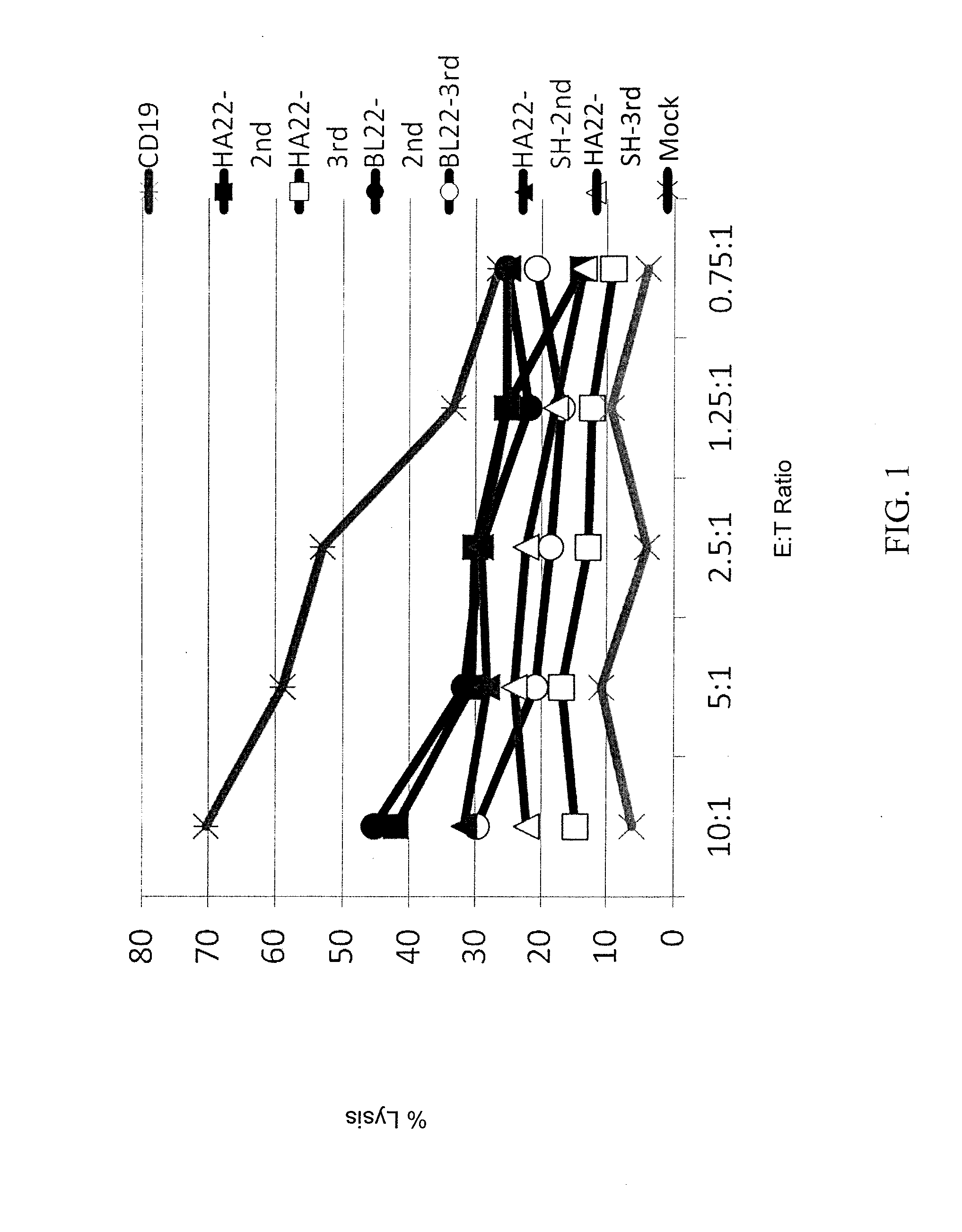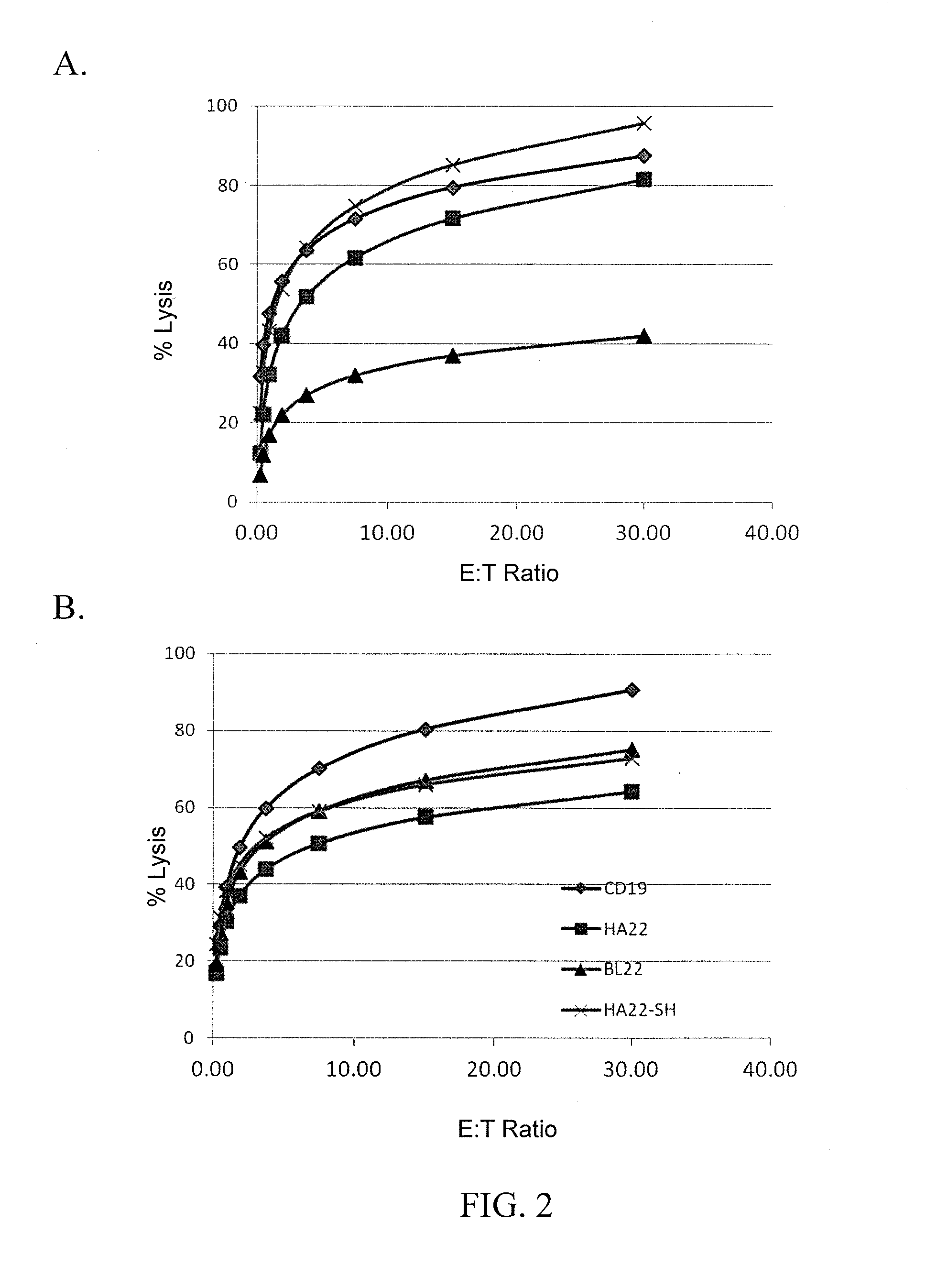Anti-cd22 chimeric antigen receptors
a technology of chimeric antigen and receptor, which is applied in the direction of immunoglobulins, peptides, drugs against animals/humans, etc., can solve the problems of poor prognosis of many cancers, including hematological malignancies, and achieve the effect of increasing the burden of tumors
- Summary
- Abstract
- Description
- Claims
- Application Information
AI Technical Summary
Benefits of technology
Problems solved by technology
Method used
Image
Examples
example 1
[0125]This example demonstrates the synthesis of anti-CD22 CARs, transduction of PBMC with anti-CD22 CARs, and analysis of CAR surface expression on transduced PBMC.
[0126]CAR-encoding sequences were synthesized using codon-optimization algorithms (Mr. Gene GmBH, Regensburg, Germany) and subcloned into “destination” vectors as described in (Zhao et al., J. Immunol., 183(9):5563-74 (2009)) encoding second generation, version 1 (CD28 transmembrane and intracellular T cell signaling domains and CD3-zeta chain intracellular T cell signaling domain); second generation, version 2 (CD8 transmembrane domain linked to CD137 and CD3-zeta intracellular T cell signaling domains); or third generation (CD8 transmembrane domain linked to CD28, CD137, and CD3-zeta intracellular T cell signaling domains) sequences as shown in Table 1 above.
[0127]Retroviral vector supernatants were created by transfecting 293GP cells with plasmids encoding CAR retroviral vectors and the RD114 envelope glycoprotein, co...
example 2
[0129]This example demonstrates the expression of CD22 and CD19 antigens on leukemia cell lines.
[0130]Human leukemia cell lines (REH, SEM, NALM-6, KOPN-8, Daudi, Raji, and K562) were evaluated for the expression level of CD19 and CD22 on the cell surface using QUANTI-BRITE PE beads (BD Biosciences) and PE-labeled anti-CD19 and anti-CD22 antibody (Table 2). “Receptor Number Per Cell” indicates the approximate absolute number of molecules per cell on each of the indicated cell lines. Data were calculated by determining antibodies bound per cell (ABC) using the CELLQUEST software (BD) data analysis tools in accordance with the manufacturer's instructions.
TABLE 2Leukemia Cell LineReceptor Number Per CellREH CD1915,100SEM CD1950,800NALM-6 CD1950,500KOPN-8 CD1960,800Daudi CD1915,000Raji CD1950,000K562 CD19REH CD227,000SEM CD227,000NALM-6 CD228,000KOPN-8 CD2215,300Daudi CD228,000Raji CD2260,800K562 CD22
example 3
[0131]This example demonstrates the effect of signaling motifs and CH2CH3 on CAR activity in vitro.
[0132]To determine if second or third generation CAR constructs provided increased lytic activity, leukemia cell lines were 51Cr labeled and used as targets in CTL assays. Effector cells were human T cells transduced with one of the following CARs: HA22-second generation (SEQ ID NO: 15), HA22-third generation (SEQ ID NO: 16), BL22-second generation (SEQ ID NO: 19), BL22-third generation (SEQ ID NO: 20), HA22-SH-second generation (SEQ ID NO: 17), HA22-SH-third generation (SEQ ID NO: 18), mock transduction (untransduced), and CD19-specific CAR. Effector cells were co-cultured with target cells at various effector to target (E:T) ratios. The results are shown in FIGS. 1 and 6A-6L. As shown in FIGS. 1 and 6A-6H, second generation CARs demonstrated superior lytic activity as compared to third generation CARs. Moreover, as shown in FIGS. 6I-6L, the addition of a CH2CH3 from IgG1 does not aff...
PUM
| Property | Measurement | Unit |
|---|---|---|
| time | aaaaa | aaaaa |
| temperatures | aaaaa | aaaaa |
| time | aaaaa | aaaaa |
Abstract
Description
Claims
Application Information
 Login to View More
Login to View More - R&D
- Intellectual Property
- Life Sciences
- Materials
- Tech Scout
- Unparalleled Data Quality
- Higher Quality Content
- 60% Fewer Hallucinations
Browse by: Latest US Patents, China's latest patents, Technical Efficacy Thesaurus, Application Domain, Technology Topic, Popular Technical Reports.
© 2025 PatSnap. All rights reserved.Legal|Privacy policy|Modern Slavery Act Transparency Statement|Sitemap|About US| Contact US: help@patsnap.com



